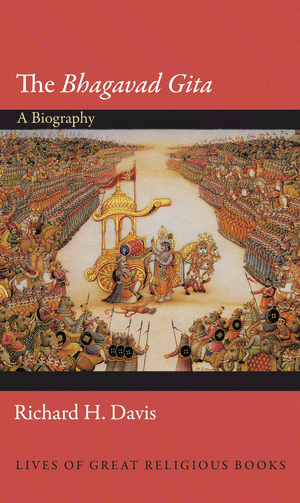
The Bhagavad Gita – A Biography
(Author: Richard H. Davis)
Readers of the Bhagavad Gita know that it opens on the eve of an impending mighty battle. The Warrior Arjuna is shaken by despair of fighting his own brethren and refuses to fight. His charioteer, Krishna, counsels on why he must go on and fight. The Gita unfolds into a spiritual discourse that has been studied and debated for centuries.
The Bhagavad Gita, a Biography explores the life and evolution of this ancient masterpiece and its meaning to various interpreters thorough its long history. Davis is a Gita and Sanskrit scholar, so he has a firm grip on the subject. He follows a timeline of scholarly research, including visits to current Gita interpreters in Maharashtra and elsewhere.
Davis elaborates on Gandhi’s interpretation of the Gita as a fight of light against darkness to Swami Vivekananda’s use of it as a spiritual shield against colonialism, while contemporary nationalists tap into its verses to rouse the masses. Medieval interpreters differed in its meaning, but the universal philosophy contained in it created many admirers in the West including Ralph Waldo Emerson, Walt Whitman, Henry David Thoreau, J. Robert Oppenheimer, and Aldous Huxley.
Davis gives the book a biographical feel, a sequence of its birth and teachings via ancient interpreters to contemporary teachers. This book serves as an introduction to the Gita, and a way to look at the life of the ancient text in various settings and contexts over the centuries along with its contemporary mooring in everyday life of Hindus. Davis writes, “Translations of the Gita also reembody the Sanskrit source in new forms, each one striving to retain some essential aspect of the original. But unlike a soul reincarnating in one new body, a new translation does not require the death of old ones. It simply adds to the expansive life of the original text. We live in a world containing many diverse embodiments of the Bhagavad Gita, a large closetful of Gitas. Each translation results from a series of choices. These choices reflect the translator’s own premises, aims, and conception of what that work most essentially is.”



